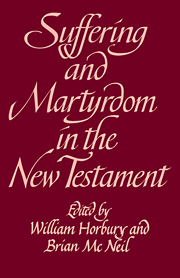 Suffering and Martyrdom in the New Testament
Suffering and Martyrdom in the New Testament Book contents
- Frontmatter
- Contents
- Abbreviations
- G. M. Styler and the Cambridge New Testament Seminar
- 1 Introduction
- 2 Did Jesus teach that his death would be vicarious as well as typical?
- 3 Imitatio Christi and the Lucan Passion narrative
- 4 The persecution of Christians in John 15: 18–16: 4a
- 5 Interchange and suffering
- 6 On the interpretation of Colossians 1: 24
- 7 Preparation for the perils of the last days: 1 Thessalonians 3:3
- 8 Maintaining the testimony of Jesus: the suffering of Christians in the Revelation of John
- 9 Martyrdom and inspiration
- 10 Suffering and martyrdom in the Odes of Solomon
- 11 Suffering and messianism in Yose ben Yose
- 12 What might martyrdom mean?
- Index of authors
- Index of references
- Index of subjects
9 - Martyrdom and inspiration
Published online by Cambridge University Press: 26 February 2010
- Frontmatter
- Contents
- Abbreviations
- G. M. Styler and the Cambridge New Testament Seminar
- 1 Introduction
- 2 Did Jesus teach that his death would be vicarious as well as typical?
- 3 Imitatio Christi and the Lucan Passion narrative
- 4 The persecution of Christians in John 15: 18–16: 4a
- 5 Interchange and suffering
- 6 On the interpretation of Colossians 1: 24
- 7 Preparation for the perils of the last days: 1 Thessalonians 3:3
- 8 Maintaining the testimony of Jesus: the suffering of Christians in the Revelation of John
- 9 Martyrdom and inspiration
- 10 Suffering and martyrdom in the Odes of Solomon
- 11 Suffering and messianism in Yose ben Yose
- 12 What might martyrdom mean?
- Index of authors
- Index of references
- Index of subjects
Summary
The Christian Church owes its survival of almost three centuries of intermittent persecution during the critical period of its formation and growth, and its emergence at the end of that time as a movement powerful enough to establish a position of total dominance in the Roman Empire, to its clear and uncompromising idea of martyrdom. This was a tradition that it had inherited to a large extent from Judaism, like itself a martyr-religion in the sense of a religion that actively and systematically trained its adherents collectively (as distinct from the individual heroes produced by Greco-Roman philosophies, such as Socrates, or the Stoic dissidents in the early Empire) for a vocation to witness to their faith not only at the cost of, but actually by means of, suffering and death. For Christians, however, the conviction that the martyr was the ideal disciple held an even more central place in belief and practice, for it was rooted in the event that stood at the heart of the Gospel, the death of Jesus. Their doctrine of martyrdom was, indeed, largely derived and developed out of the response of the orthodox Jewish resistance movement to the persecution under Antiochus Epiphanes, but there are significant differences of attitude between such writings as Daniel, 2 Maccabees and 4 Maccabees, on the one hand, and the New Testament and second-century Christian literature on the other. The former tend to be primarily defensive.
- Type
- Chapter
- Information
- Suffering and Martyrdom in the New TestamentStudies presented to G. M. Styler by the Cambridge New Testament Seminar, pp. 118 - 135Publisher: Cambridge University PressPrint publication year: 1981
- 3
- Cited by


